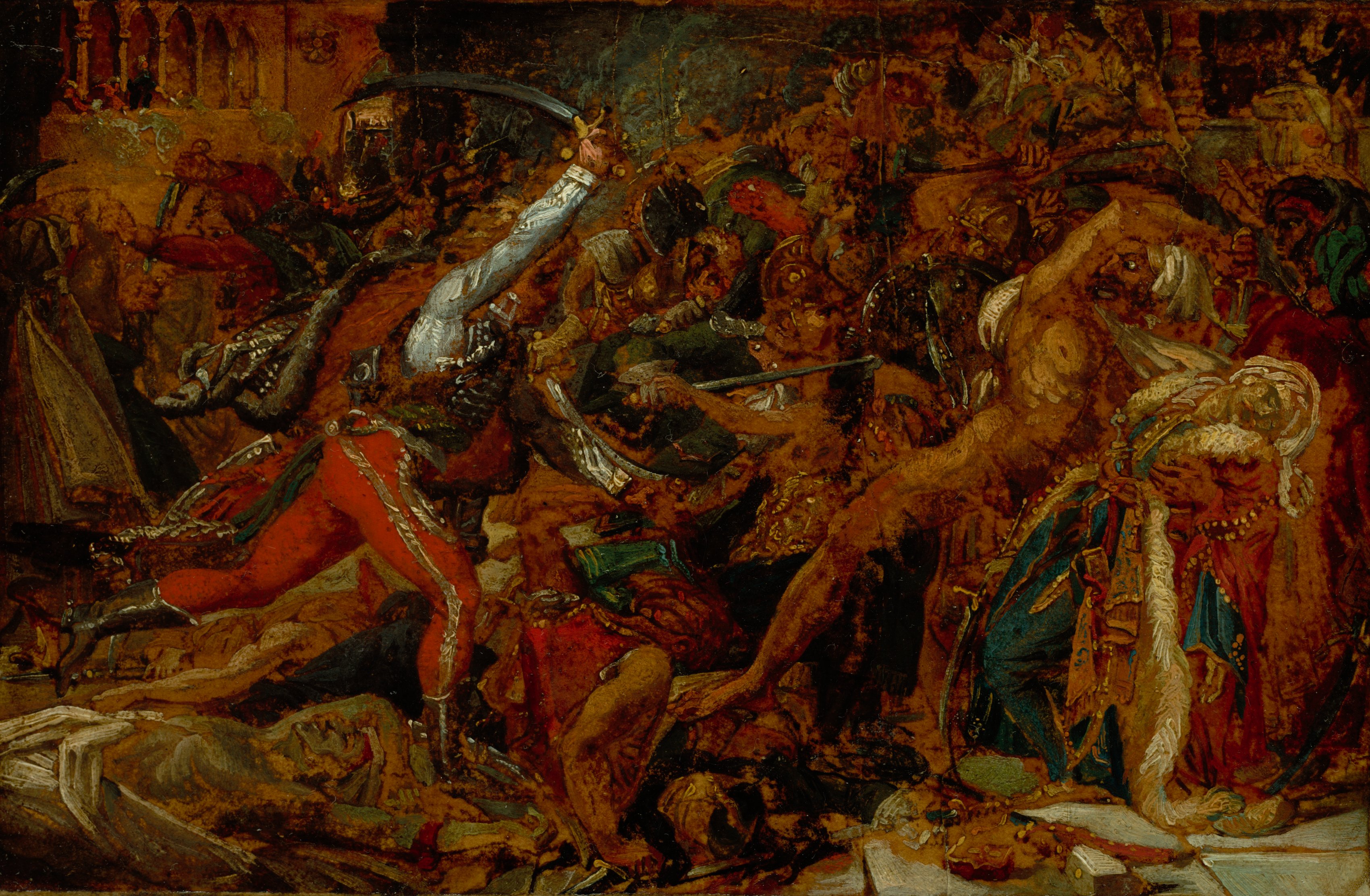The Cleveland Museum of Art
Collection Online as of April 19, 2024

Sketch for "The Revolt at Cairo"
c. 1809
(French, 1767–1824)
Framed: 25 x 33 x 6.5 cm (9 13/16 x 13 x 2 9/16 in.); Unframed: 15.2 x 23.3 cm (6 x 9 3/16 in.)
Gift of Eugene Victor Thaw 1965.310
Location: not on view
Description
Throughout the 1800s and into the 1900s, prints, paintings, and photographs, like Louis Haghe’s Egypt and Nubia series, brought back by artists who voyaged to Egypt, inspired American and European artists, architects, and designers to emulate ancient Egyptian motifs and styles. Egyptomania blossomed through the 1800s and can be seen in architecture around cities like Washington, DC, and in the interiors of aristocratic homes, as well as in funerary monuments, such as in Lake View Cemetery in Cleveland, Ohio. Looking back at these creations provides an interesting historical groundwork for debating who has the right to interpret Egyptian motifs and styles.- Paris sale, Drouot, collection Coutan-Hauguet, 16-17 December 1889 (lot 16), "Géricault [annotation gives: Girodet]: Révolte du Caire, 21 Octobre 1798, première pensée: esquisse," 15 x 24 cm, for ff 309 to Guillon [annotated]. Eugene Victor Thaw, New York. Given to the CMA in 1965.
- Argencourt, Louise d', and Roger Diederen. Catalogue of Paintings. Pt. 4. European Paintings of the 19th Century. Cleveland: Cleveland Museum of Art, 1974. Mentioned and reproduced: P. 298-300, Vol. I, no. 107Bellenger, Sylvain, ed. Girodet, 1767-1824. [Paris, France]: Gallimard, 2006. Mentioned and reproduced: pp. 316-319, cat. 56Lisby, Darnell-Jamal. “Egyptomania: Engaging the conflicted obsession." Cleveland Museum of Art Members Magazine vol. 63, no. 1 (2023): 12-15. Reproduced: P. 12.
- Egyptomania: Fashion's Conflicted Obsession. The Cleveland Museum of Art, Cleveland, OH (organizer) (April 1, 2023-January 28, 2024).Art Institute of Chicago, IL (2/11/2006 - 4/30/2006), Metropolitan Museum of Art, NYC (5/22/2006 - 8/27/2006) and the Musée des Beaux Arts, Montréal (10/12/2006 - 1/21/2007): "Girodet: Romantic Rebel" (Paris: Musée du Louvre Êdition ©2005), ex. cat. 56, p. 317.Girodet: Romantic Rebel. The Art Institute of Chicago, Chicago, IL (February 11-April 30, 2006); The Metropolitan Museum of Art, New York, NY (May 22-August 27, 2006); Montréal Museum of Fine Arts, Montreal, Quebec, Canada (October 12, 2006-January 21, 2007).French Drawings from the Collection. The Cleveland Museum of Art, Cleveland, OH (organizer) (December 13, 1994-March 12, 1995).Triumph und Tod des Helden (Triumph and Death of the Hero): European History Painting from Rubens to Manet. Wallraf-Richartz Museum, 50667 Cologne, Germany (organizer) (October 30, 1987-January 10, 1988); Kunsthaus Zürich, CH-8024 Zürich, Switzerland (March 3-April 24, 1988); Musée des Beaux-Arts de Lyon, 69001 Lyon, France (May 19-July 17, 1988).Cologne, Wallraf-Richartz-Museum; Kunsthaus Zürich; Lyons, Musée des Beaux-Arts. Triumph und Tod des Helden: Europäische Historienmalerei von Rubens bis Manet (1987-88), no. 134 (repr.).Providence, Bell Gallery, Brown University. All the Banners Wave: Art and War in the Romantic Era 1792-1851 (1982), no. 11b (repr.).Memorial Art Gallery of the University of Rochester (N.Y.); Neuberger Museum, State University of New York at Purchase. Orientalism: The Near East in French Painting, 1800-1880 (1982), no. 45, fig. 14.Kunsthalle Hamburg. Goya: Das Zeitalter der Revolutionen 1789-1830 (1981), 534, no. 393, pl. xx.Goya: das Zeitalter der Revolutionen, 1789-1830 (Goya: The Age of Revolutions, 1789-1830). Hamburger Kunsthalle, Hamburg, Germany (organizer) (October 16, 1980-January 4, 1981).Idea to Image: Preparatory Studies from the Renaissance to Impressionism. The Cleveland Museum of Art (organizer) (February 19-March 23, 1980).French Nineteenth Century Oil Sketches: David to Degas. Ackland Art Museum, University of North Carolina, Chapel Hill, NC, Chapel Hill, NC (organizer) (March 5-April 30, 1978).Chapel Hill, William Hayes Ackland Memorial Art Center, University of North Carolina. French Nineteenth Century Oil Sketches: David to Degas (1978), no. 39, fig. 39.Kansas City, Nelson Atkins Museum. The Taste of Napoleon (1969), no. 35.Year in Review: 1965. The Cleveland Museum of Art, Cleveland, OH (organizer) (October 27-November 14, 1965).cma; Brooklyn Museum; Saint Louis Art Museum; Glasgow Art Gallery and Museum. The Realist Tradition: French Painting and Drawing 1830-1900 (1980-82), 72-73 (repr.). Text by Gabriel P. Weisberg.
- {{cite web|title=Sketch for "The Revolt at Cairo"|url=false|author=Anne-Louis Girodet de Roucy-Trioson|year=c. 1809|access-date=19 April 2024|publisher=Cleveland Museum of Art}}
Source URL:
https://www.clevelandart.org/art/1965.310